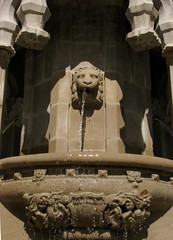Well, another stinker of a Bomber season has come to a close. I wonder what Teddy the Chimp would make of all this ?! Yes, long before Buzz and Boomer, the Bombers had a mascot who was a local celebrity in his own right !
"Teddy the Chimp" was born in Africa and shipped to Canada in 1957 at the age of seven months. His owners were Bob and and Lillian Page of
288 Waterloo Street who owned 16 other monkeys including macaques and a baboon, (which is surprising considering their home is listed at just over 1,000 sq ft !)
Bob, a local businessman, was heavily involved in the local sports scene. He coached rugby and figure skating. He was a founder and the first president of the Assiniboine Figure Skating Club in 1945 (and appears to have disappeared in the late 1980s.)
The Page children, Robert and Yvonne, were both high-level figure skaters at the Winter Club
winning championships and eventually touring with professional shows.
Chimps were particularly popular and newsworthy at the time. Aside from their intelligence and entertainment value, they were now on the cutting edge of science and going
into space.
The following year Teddy was old enough to be with the public and 'trained to perform all the clever and amusing tricks that you will find so hilarious'. The tricks included tricycle riding. Ads appeared in the classified sections encouraging his rental for trade shows and children's parties.
 |
Teddy at The Bay (April 5, 1958 Wpg Free Press)
|
His early gigs included regular appearances in The Bay's toy department. Sometimes solo, sometimes with a collection of the smaller monkeys in another cage in a display called "Monekyland".
The monkey - Bay connection did not always go smoothly.
In 1957 three of the smaller monkeys escaped and spent a couple of days prowling the store. They were seen in the manager's office, peering down from the light fixtures onto customers in the dress shop and, more often than not, in The Paddlewheel swinging from the artificial trees or riding the moving paddle wheel.
In December 1959 Teddy escaped from his second floor cage and raced through the store finally coming to rest on a seat in the third floor beauty parlour. The 'Santa' who was working near Teddy was able to coax him out of the salon and into his arms. That appears to be the end Teddy's career and a Bay Man.
In October 1959 Teddy escaped from home and broke into a house at 799 Wellington Crescent. Police responded to find him sitting in the bedroom trying on the lady of the house's lipstick. Page was called to retrieve Teddy. The home owner told the Free Press: "...when the chimp's handler arrived he told him 'go over and tell the man your sorry for scaring him'. Then, the darn thing came and sat in my lap and tried to kiss me."
The homeowner refused to pose for a picture with Teddy for the paper.
 |
Teddy ready for Grey Cup (Nov. 29, 1959 Wpg Free Press)
|
In 1958 the Bombers decided that they wanted a part of Teddy and called in him for a couple of games. The following season he was the team's 'Official Mascot'. One of his duties was to travel to the Grey Cup in Toronto with Miss Blue Bomber Judy Cox. Teddy was in the stands and atop the Winnipeg float in the Grey cup parade. The association with the Bombers lasted until 1962.
 |
Teddy an honourary Petty Officer (Oct 13, 1962, Wpg Free Press)
|
Teddy made a number of other appearances around the city in his heydey. He was at the 1960 national badminton championships at the Arena. He entertained before a number of Rainbow Stage performances between 1959 and 1962 and made news when the past president of MTC brought him to a show as his companion ! In January 1961 he presented ribbons to the winners of a YMCA swim meet at the Sherbrook Pool. In October 1962 he was made an honourary Petty Officer in the Royal Canadian Sea Cadet Corps.
In late 1962 Teddy disappears from the Winnipeg scene and I cannot find anything more on him. There are two possibilities.
The Page family did move to California, though I don't know when. After 1962 I cannot find mention of any family members in the Free Press including the children who appeared regularly in the sports pages. They may have moved then, taking Teddy with them.
If the family did stay in Winnipeg, by 1962 Teddy was almost five years old. A mature male chimp is 3 - 4 feet tall and weigh over 100 lbs. Perhaps he was shipped somewhere that could better take care of him.
In Teddy's five season association with the Bombers, 1958 - 1962, they won the Grey Cup four times.
In 1981 son Robert Kingsborough Page died in Canyon County, California. Bob Page passed away on July 29, 2000 in Arcata, California. He was survived by wife Lillian and daughter Yvonne.
































